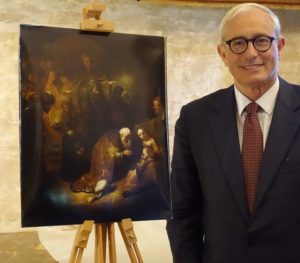A painting fell off a wall in a Rome house.
The owners sent it to an art restorer, who began removing layers of varnish.
There are many copies of Rembrandt’s “The Adoration of the Magi” (1632-1633), but no one knew where the original was, or if it still existed.
But as the restorer carefully worked on the fragile painting, she realized this was no copy. And she wasn’t exactly blasé about it:
“This is the moment in which we must overcome the vertigo capable of making us sink into that wonderful sense of belonging to history. It is a thrill that has no equal, which vibrates until it drags you into an unstoppable impulse of morbid curiosity. I don’t fight it and I let myself be carried away by the spell.”
Rembrandts aren’t exactly extremely rare. Rembrandt van Rijn (bio here) ran an art factory that cranked out paintings like soup cans. There are (or were) hundreds of Rembrandt originals. Nevertheless, the quality of his works are such that Rembrandt is one of history’s most famous artists, his works are highly prized, and on the very rare occasions they come on the private market (many are in museums), they fetch huge prices.
This one is valued at “between $83.5 million and $239 million,” but the family that owns it “plans to keep it but will lend it to museums and galleries.” I would, too; no capital gains taxes, and someone else is paying for security. And how do you insure it in a private home?
The public, for whatever reason, is fascinated by high-priced artworks, especially those with an enthralling story behind them. If you’re that type, you may enjoy reading Jonathan Harr’s The Lost Painting, an art detective story about a lost masterpiece by Michelangelo Carravaggio (bio here), a total scumbag who was murdered at age 39 and probably had it coming. (I picked up the book at a public library several years ago; the Seattle Public Library has it here, or you can buy it from Amazon here.) Geniuses don’t necessarily live respectable lives.
Rembrandt’s life was less violent, but wasn’t exactly boring. He made a lot of money in his lifetime, but spent even more, and wasn’t much of an investor. Or a very honest one; he engaged in insider trading of his own works. He eventually went bankrupt, and was forced to liquidate his assets, including his rather substantial house.
He and his wife lost 3 of their 4 children in childhood, which wasn’t all that unusual for the 17th century, and then he lost her to tuberculosis, which wasn’t unusual for that time, either. Soon after her death, he shacked up with the caretaker he hired to babysit his son, and when she sued him for “breach of promise” (i.e., to marry her), he sought to have her thrown into an insane asylum. (The obvious argument here would be she had to be nuts to want to marry him.)
He then shacked up with the maid, and had a daughter by her, which got her banned from communion for having “committed the acts of a whore with Rembrandt the painter”. For his part, “Rembrandt was not summoned to appear for the Church council because he was not a member of the Reformed Church.” He outlived her, and also his son, and was buried in a pauper’s grave and after 20 years his bones were destroyed to make room for the next pauper.
And then there’s Van Gogh, another Dutch painter, whose story is well known. One might ask, why do famous painters live such screwed-up lives? The answer, of course, is they’re human like the rest of us, and painting is just another job, done to make money to pay the rent.
 Photo: This isn’t my idea of a quarter-billion dollars, and that someone would pay this much for it suggests they don’t pay enough taxes, but I guess it’s worth whatever someone will pay for it. The insane prices paid for art pieces is another animal, and you have Bitcoin. Meanwhile, human beings labor elbow-to-elbow in meatpacking plants for $10 an hour. That makes the distribution of wealth look very screwed up, which can spawn Marxist movements, but I digress …
Photo: This isn’t my idea of a quarter-billion dollars, and that someone would pay this much for it suggests they don’t pay enough taxes, but I guess it’s worth whatever someone will pay for it. The insane prices paid for art pieces is another animal, and you have Bitcoin. Meanwhile, human beings labor elbow-to-elbow in meatpacking plants for $10 an hour. That makes the distribution of wealth look very screwed up, which can spawn Marxist movements, but I digress …